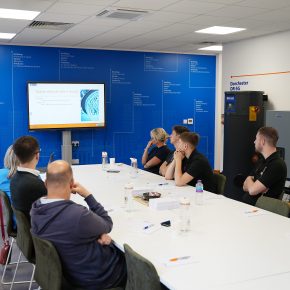
The Passive House Standard: How to achieve optimum air quality
The Passive House Standard focuses on delivering maximum air comfort and quality via post-heating or post-cooling the fresh air flow, without air recirculation.
To achieve the standard in a central European climate, a certain criteria must be followed from the planning process’ outset.
Passive House criteria
Space heating and cooling demand
All Passive House buildings should be able to achieve an annual heating and cooling demand of 15KWh/m2 per year – it should not exceed this.
Alternatively, a Passive House’s peak heat load must be below 10W/m2.
Primary energy demand
Overall, the primary energy consumption for heating, cooling, domestic hot water and auxiliary and household electricity must not surpass 120kWh/m2 per year.
Passive House homes offer optimum air quality, maximising comfort for their occupants
Airtightness
A Passive House building must not leak more air than 0.6 times the house volume per hour.
If airtightness is not incorporated into the design of the building from the start, it is unlikely that it will obtain the Passive House Standard.
The criteria have been designed to ensure the delivery of low energy consumption, longevity and healthy air.
In addition to offering these benefits, a Passive House should be environmentally friendly and largely affordable.
The criteria are a logical process, working together to achieve the benefits. These guidelines should not be looked as a menu of mix and match options.
Delivering a Passive House
To obtain certification to the Passive House standard, it is recommended that designers seek the assistance of the Passive House Planning Package (PHPP).
Factors, such as solar design and landscape, should also be assessed.
High quality materials and fabrics should be used in the construction of the home, in order to ensure efficient thermal insulation and the elimination of thermal bridges.
Advanced window technology is also useful; meanwhile, mechanical heat recovery ventilation systems (MVHR) should be researched thoroughly to ensure that air quality and comfort is optimised.
Zehnder Group UK Ltd
Unit 4, Watchmoor Point
Camberley
Surrey
GU15 3AD
UK
01276 605800
Visit Supplier's page
Latest news

24th April 2024
The lowdown on Origin’s New Soho Offering
Origin’s Soho External Door is the first launch in its new generation of products, setting a higher standard for the fenestration industry.
Posted in Access Control & Door Entry Systems, Aluminium Products, Architectural Ironmongery, Articles, Building Industry News, Building Products & Structures, Building Systems, Doors, Innovations & New Products, Posts, Restoration & Refurbishment, Retrofit & Renovation, Security and Fire Protection
24th April 2024
Mitsubishi Electric welcomes new code of conduct for smart appliances
Mitsubishi Electric welcomes a new code of conduct on energy smart appliances which the European Union (EU) announced yesterday at the Hannover Fair in Germany.
Posted in Air Conditioning, Articles, Building Industry Events, Building Industry News, Building Products & Structures, Building Regulations & Accreditations, Building Services, Exhibitions and Conferences, Facility Management & Building Services, Heating Systems, Controls and Management, Heating, Ventilation and Air Conditioning - HVAC, Plumbing, Retrofit & Renovation, Seminars, Sustainability & Energy Efficiency
24th April 2024
Hamworthy Heating expands CIBSE approved CPD modules with new hot water series
Hamworthy Heating, technical experts in commercial heating and hot water products, announce the expansion of its market leading CIBSE approved Continuing Professional Development (CPD) portfolio with the launch of three new learning modules.
Posted in Articles, Building Industry Events, Building Industry News, Building Products & Structures, Building Services, Continuing Professional Development (CPD's), Facility Management & Building Services, Heating Systems, Controls and Management, Heating, Ventilation and Air Conditioning - HVAC, Plumbing, Retrofit & Renovation, Seminars, Training
24th April 2024
New technology partnership brings Passivent ventilation products to IESVE
Passivent has partnered with Integrated Environmental Solutions (IES) to make a number of its products available to model within the Virtual Environment (VE) platform IESVE.
Posted in Air Conditioning, Articles, Building Industry News, Building Products & Structures, Building Services, Facility Management & Building Services, Heating, Ventilation and Air Conditioning - HVAC, Information Technology, Innovations & New Products, Posts, Retrofit & Renovation, Roofs, Ventilation
 Sign up:
Sign up: